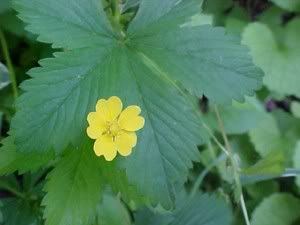

Potentilla canadensis, P reptans, P anserina
Folk Names: Crampweed, Finger Leaf, Five Fingers, Five Finger Blossom, Five Finger
Grass, Goose Tansy, Goosegrass, Moor Grass, Pentaphyllon, Potentilla, the Seventh Bread
(Gaelic), Silver Cinquefoil, Silverweed, Sunkfield; P anserina: Argentine, Crampweed, Goose
Gray, Goosewort, Moon Grass, Moor Grass, Prince’s Feathers, Silvery Cinquefoil, Synkefoyle,
Trailing Tansy, Wild Agrimony, Wild Tansy
Description: The cinquefoil is a low perennial of the rose family found in Europe and America from Nova Scotia to Ontario and south to Virginia. The root sends out a procumbent stem up to five feet long. It is a slender runner, rooting at the nodes with a rosette of basal, pinnate leaves. The rosette consists of thirteen to twenty-one oblong, serrate leaflets, dark green on top and silvery beneath. The leaves along the stem are alternate and compound with long stalks. They are palmately divided into five to seven pinnate, or three-lobed, sharp-toothed, obovate to oblanceolate leaflets. The veins are hairy. The flowers are bright yellow, sometimes white. Appearing from April to August, they are found singly or in branched clusters on long peduncle from the leaf axils. Five petals alternate with the sepals, and the fruits form in clusters on the sepals.
P anserina can be found in damp soil and along streams. It is a Eurasian plant, but is also found from Nova Scotia to Alaska and south to New York, Iowa, New Mexico, and California. Like P canadensis, the stem is prostrate and the plant reproduce via its rooting runners which can extend from three to six feet. The leaves pinnate, with seven to twenty-five toothed leaflets, increasing in size to the tip. From June to August, each plant produces a solitary five-petaled bright yellow flower on a two to twelve inch leafless stalk. Flowers close at night and on cloudy days. They secrete a “honey” on a ring-like ridge surrounding the base of the stamen. Though plants may cross pollinate through insect visitors, they are also self-pollinating.
Effects: strong
Planet: Mercury, Jupiter Zodiac: Virgo
Element: fire
Associated Deities:
Traditions:
The word Potentilla comes from Latin for “powerful.” It refers to the belief in plant’s
ability to cure various illnesses.
Only medieval knights who had achieved self-mastery were permitted to use the five-leaf emblem of the Cinquefoil on their shield as symbol of the five senses.
Bacon said that frogs were attracted to this herb.
Magic:
Gather a perfect five-fingered leaf during the waxing of the moon at midnight on a
Wednesday night and press it in a book. It will provide protection for any traveler. Hang at the
door or on the bed for protection. It will also provide restful sleep. Make hole in an egg and
drain. Fill with it cinquefoil and it tape shut. Keep this charm somewhere on your property for
protection.
While it was said to be used in hexes, cinquefoil was also thought that witches feared this herb. To curse enemy, make a male or female wax doll. Burn cinquefoil to ashes and mix it with a handful of soot, your enemy’s hair and nail clippings and wine. Baste the doll and each time you baste, say:
I burn thee as I curse thee,
I curse thee as I burn thee.
An infusion from the leaves may be used to bathe the forehead and hands nine times to wash away hexes and curses. Use as a purification bath sachet and add to bath as least once over seven days to wash away hexes and curses.
The five points represent love, money, health/luck, power, and wisdom and can be used for any of these purposes. Cinquefoil is added to love potions and used in divination spells. Found with seven leaflets, it may be placed under the pillow to dream of your future love or mate. Cinquefoil may also be made into an incense to dream of one’s future mate.
Carry for eloquence when asking for favors from officials. It is also a useful charm in court. Carry in a red flannel bag to control anyone.
Mix the root with water used to quench iron. This is useful to staunch wounds.
Known Combinations:
Fishermen added a bait consisting of cinquefoil to their nets to bring in heavier catches.
The bait included corn boiled with thyme and marjoram water mixed with nettles, cinquefoil, and
the juice of the house leek.
Cinquefoil is one of the herbs supposedly used in the Medieval flying ointment. Other ingredients in addition to the cinquefoil included smallage and wolfsbane mixed with the fat of exhumed children and wheat flour.
Medical Indications: Parts Used: herb, leaves; Gather the tops in June, the roots in April.
Cinquefoil is an antispasmodic, astringent (due to its high tannin content), and a
disinfectant. A tea is made from leaves for fevers. It may also be used as a gargle mixed with
honey for inflammation of the mouth and gums and sore throat. It is also an analgesic.
Cinquefoil has long be thought to have healing properties. It may be used as a poultice for wounds. A tea with water and milk treats diarrhea, dysentery, and menstrual cramping. The dried tops are also infused for difficult menstruation and diarrhea.The root bark is used on nosebleeds and other internal bleeding.
The tea may be used externally for skin problems, and a strong distillation soothes sunburn or freckles.
Nutrition:
Native Americans, Eskimos, and some people of northern Europe roasted the roots. The
root was also added to soups and stews. Boiled for twenty minutes, it has been compared in taste
to turnips, parsnips, sweet potatoes, or chestnuts.
Mercantile Uses:
Cinquefoil is suitable in livestock feed. The only animals which refuse it are sheep.